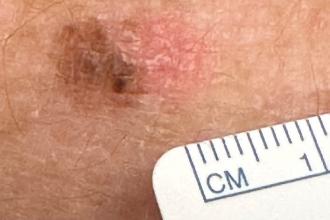Tool to help with early detection of melanoma
 |
| Skin cancer probe |
Work is being done on a simple compact laser probe that can distinguish between harmless moles and cancerous ones in a matter of seconds. Daniel Louie, a PhD student, constructed the device as part of his studies in biomedical engineering at the University of British Columbia. The probe works on the principle that light waves change as they pass through objects. Researchers aimed a laser into 69 lesions from 47 volunteer patients at the Vancouver General Hospital Skin Care Centre and studied the changes that occurred to this light beam. Because cancer cells are denser, larger, and more irregularly shaped than normal cells, they caused distinctive scattering in the light waves as they passed through. Researchers were able to invent a novel way to interpret the patterns instantaneously. This optical probe can extract measurements without needing expensive lenses or cameras, and it can provide a more easily interpreted numerical result like those of a thermometer. Although the components of the probe cost only a few hundred dollars, it is not envisioned to be a consumer product. Tim Lee, an associate professor of skin science and dermatology at UBC and a senior scientist at both BC Cancer and the Vancouver Coastal Health Research Institute, supervised the work. He believes the device would be a good future addition to standard cancer screening methods, but not a replacement.
This is a joint project between UBC, BC Cancer, and the Vancouver Coastal Health Research Institute. Researchers hope to eventually achieve Health Canada certification and approval before being able to offer this testing through health professionals. This will require further refinement of the technology and additional clinical testing in more patients.
Study authors are Daniel C. Louie, Jamie Phillips, Lioudmila Tchvialeva, Sunil Kalia, Harvey Lui, Wei Wang, and Tim K. Lee. The article describing the study, “Degree of optical polarization as a tool for detecting melanoma: Proof of principle,” is in the Journal of Biomedical Optics. It is available online at https://doi.org/10.1117/1.JBO.23.12.125004.

